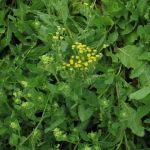| Common Name: |
Alecost |
| Other Names: |
Costmary |
| Botanical Name: |
Tanacetum balsamita syn. Balsamita major, Chrysanthemum balsamita |
| Genus: |
Tanacetum |
| Family: |
Asteraceae |
| Native Location: |
Europe to C Asia |
| Cultivation: |
Well-drained to dry, stony soil in sun. Remove dead flower heads or Tanacetum parthenium to prevent excessive self-seeding. Tanacetum vulgare is invasive. |
| Propagation: |
By seed sown at 10-13°C (50-55°F) in spring (species and some variants only); by division in spring or autumn; by basal cuttings in spring; by semi-ripe cuttings in summer. |
| Harvest: |
Whole plants (T. parthenium, T. vulgare) are cut when flowers, and leaves are picked as required, and used fresh or dried in infusions, liquid extracts, powders, and tinctures. Tanacetum vulgare is distilled for oil. Leaves (T. parthenium) are sometimes eaten fresh, or dried for use in tablets to treat migraine, rheumatism, and arthritis. Flowers (T. cinerariifolium are picked as they open and are dried for powder. |
| Height: |
90cm (36in) |
| Width: |
60cm (24in) |
| Variants: |
Subsp. balsametoides var. tormentosum
(Camphor Plant)
Has camphor-scented foliage.
Height: 1m (3ft)
Width: 1m (3ft) |
|
| Hardiness: |
Z4-8 |
| Parts Used: |
Leaves |
| Properties: |
A bitter, astringent, laxative herb with a balsam-mint aroma. It improves digestion and liver function. |
| Medicinal Uses: |
Now obsolete medicinally, but once used internally as a liver and gall bladder remedy, and externally for insect stings. |
| Culinary Uses: |
Fresh leaves may be added with discretion to salads, dressings, meat and vegetable dishes; dried leaves are infused as tea. |
| Ecomonic Uses: |
Dried leaves added to potpourris. Leaves used in brewing beer. |
| Bibliography: |
The Encyclopedia of Herbs by Deni Bown Copyright © 1995, 2001 Dorling Kindersley Limited. pg. 381 |

